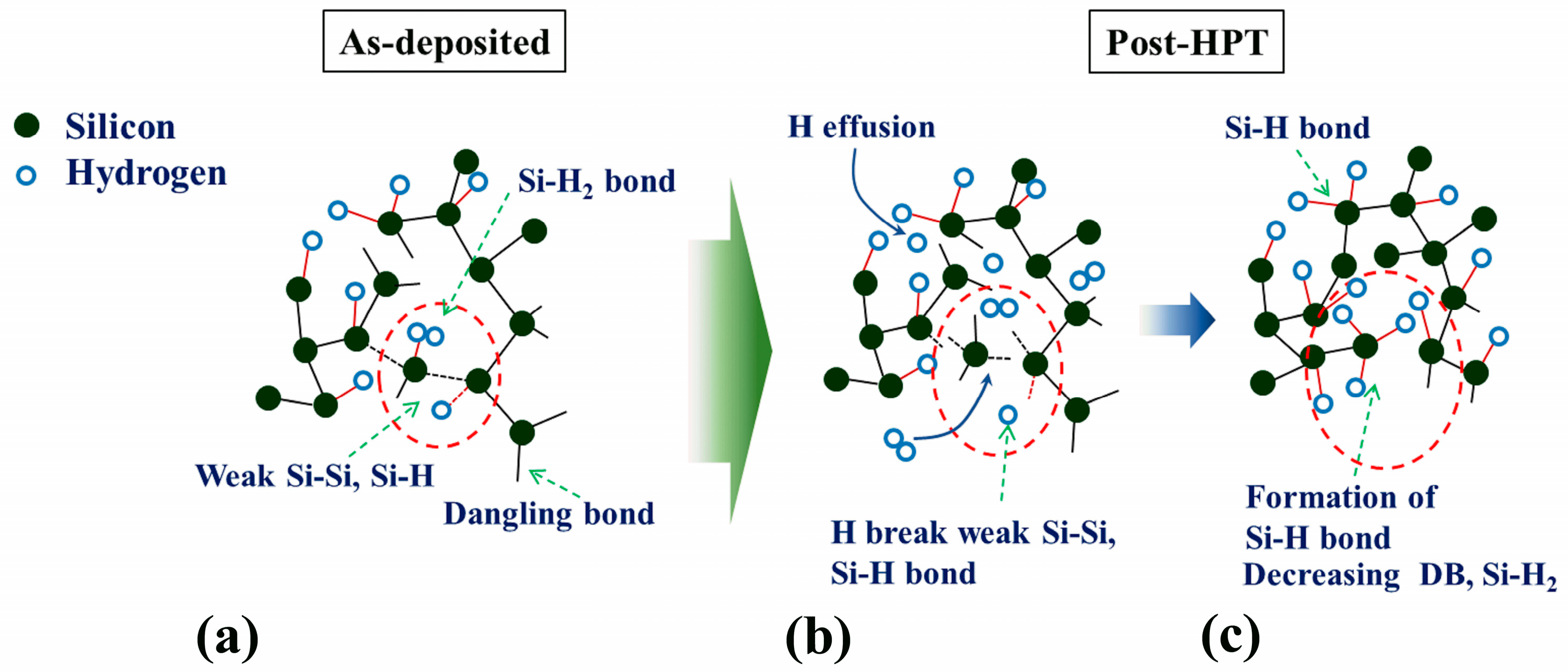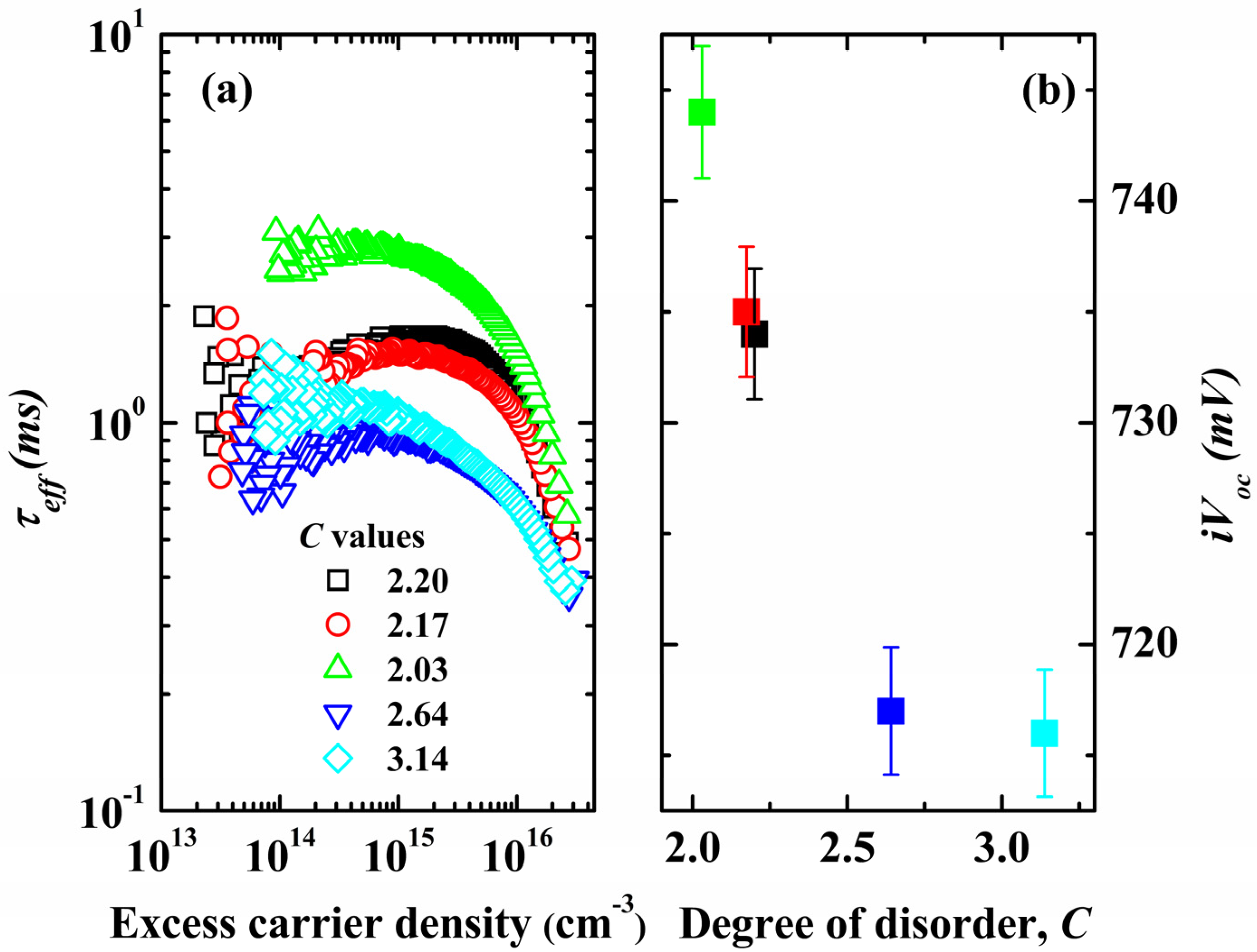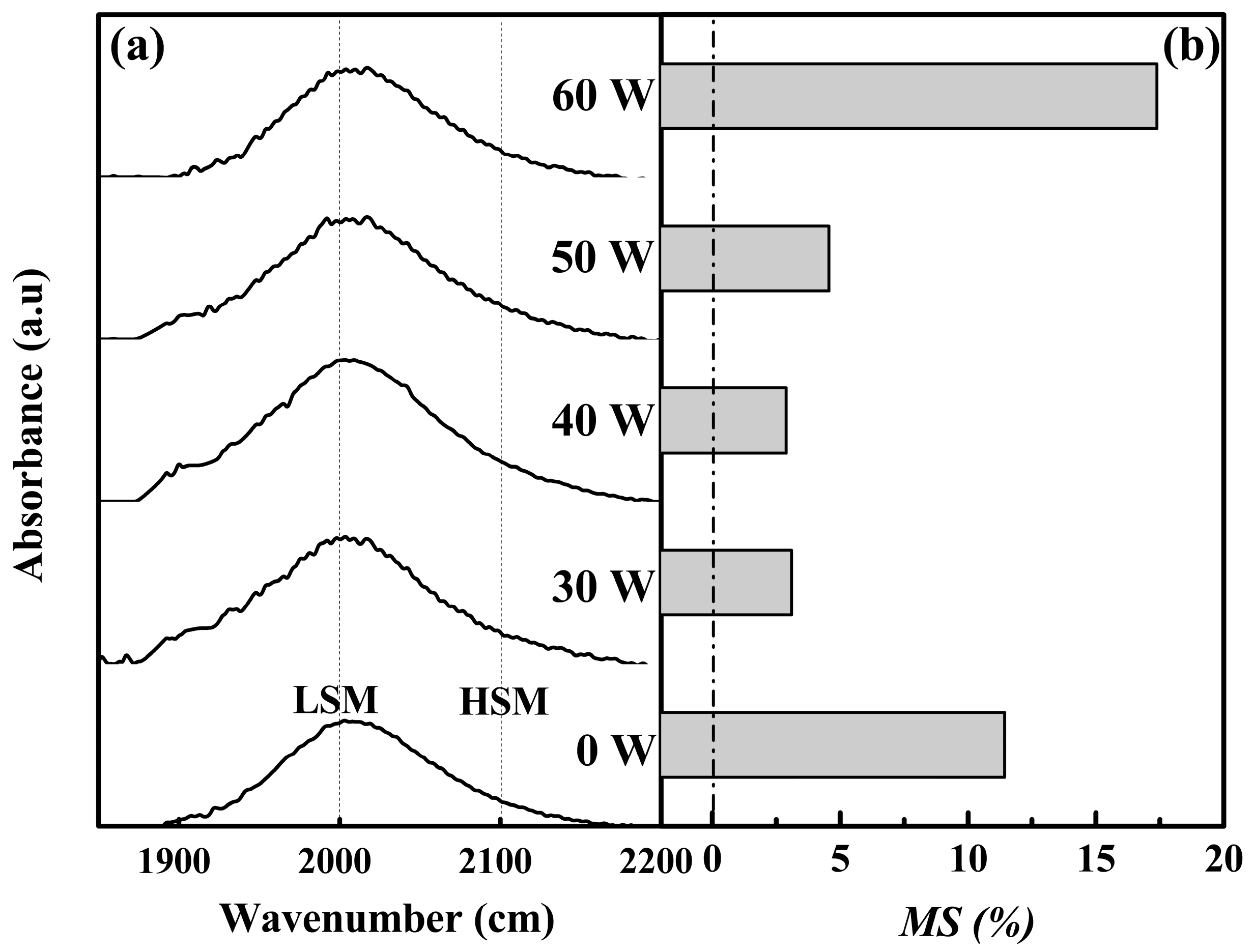The Impact of the Micro-Structure within Passivated Layers on the Performance of the a-Si:H/c-Si Heterojunction Solar Cells
Abstract
:1. Introduction
2. Materials and Methods
3. Results & Discussions
4. Conclusions
Author Contributions
Funding
Conflicts of Interest
References
- Fujiwara, H.; Kondo, M. Effect of a-Si:H layer thickness on performnace of a-Si:H/c-Si heterojunction solar cells. J. Appl. Phys. 2007, 101, 054516. [Google Scholar] [CrossRef]
- Yoshikawa, K.; Kawasaki, H.; Yoshida, W.; Irie, T.; Konishi, K.; Nakano, K.; Uto, T.; Adachi, D.; Kanematsu, M.; Uzu, H.; et al. Silicon heterojunction solar cell with interdigitated back contacts for a photoconversion efficiency over 26%. Nat. Energy 2017, 2, 308. [Google Scholar] [CrossRef]
- Li, H.; Zeng, X.B.; Xie, X.B.; Yang, P.; Li, J.Y.; Zhang, Z.D.; Wang, Q.M. The amorphous/crystalline silicon interface research of HIT Solar Cells by simulation. Adv. Mate. Res. 2013, 773, 124–131. [Google Scholar] [CrossRef]
- Taguchi, M.; Terakawa, A.; Maruyama, E.; Tanaka, M. Obtaining a higher Voc in HIT Cells. Prog. Photovolt. 2005, 13, 481–488. [Google Scholar] [CrossRef]
- Wen, X.; Zeng, X.; Liao, Z.; Lei, Q.; Yin, S. An approach for improving the carriers transport properties of a-Si:H/c-Si heterojunction solar cells with efficiency of more than 27%. Sol. Energy 2013, 96, 168–176. [Google Scholar] [CrossRef]
- Gogolin, R.; Ferré, R.; Turcu, M.; Harder, N.P. Silicon heterojunciton solar cells: Influence of H2-dilution on crll perfromance. Sol. Energy Mater. Sol. Cells 2012, 106, 47–50. [Google Scholar] [CrossRef]
- Kim, S.K.; Lee, J.C.; Park, S.J.; Kim, Y.J.; Yoon, K.H. Effect of hydrogen dilution on intrinsic a-Si:H layer between emitter and Si wafer in silicon heterojunction solar cell. Sol. Energy Mater. Sol. Cells 2008, 92, 298–301. [Google Scholar] [CrossRef]
- Tsunomura, Y.; Yoshimine, Y.; Taguchi, M.; Baba, T.; Kinoshita, T.; Kanno, H.; Sakata, H.; Maruyama, E.; Tanaka, M. Twenty-two percent efficiency HIT solar cell. Sol. Energy Mater. Sol. Cells 2009, 93, 670–673. [Google Scholar] [CrossRef]
- van Sark, W.G.J.H.M.; Korte, L.; Roca, F. Physics and Technology of Amorphous-Crystalline Heterostructure Silicon Solar Cells, 1st ed.; Springer: Berlin/Heidelberg, Germany, 2008; pp. 1–12. [Google Scholar]
- Deligiannis, D.; Vasudevan, R.; Smets, A.H.M.; van Swaaij, R.A.C.M.M.; Zeman, M. Surface passivation of c-Si for silicon heterojunction solar cells using high-pressure hydrogen diluted plasmas. AIP Adv. 2015, 5, 97165. [Google Scholar] [CrossRef]
- Das, U.K.; Burrows, M.Z.; Lu, M.; Bowden, S.; Birkmire, R.W. Surface passivation and heterojunction cells on Si (100) and (111) wafers using dc and rf plasma deposited Si:H thin films. Appl. Phys. Lett. 2008, 92, 63504. [Google Scholar] [CrossRef]
- Descoeudres, A.; Barraud, L.; De Wolf, S.; Strahm, B.; Lachenal, D.; Guérin, C.; Holman, Z.C.; Zicarelli, F.; Demaurex, B.; Seif, J.; et al. Improved amorphous/crystalline silicon interface passivation by hydrogen plasma treatment. Appl. Phys. Lett. 2011, 99, 123506. [Google Scholar] [CrossRef]
- Mews, M.; Schulze, T.F.; Mingirulli, N.; Korte, L. Hydrogen plasma treatments for passivation of amorphous-crystalline silicon-heterojunctions on surfaces promoting epitaxy. Appl. Phys. Lett. 2013, 102, 122106. [Google Scholar] [CrossRef]
- Morral, A.F.I.; Cabarrocas, P.R.I.; Clerc, C. Structure and hydrogen content of polymorphous silicon thin films studied by spectroscopic ellipsometry and nuclear measurements. Phys. Rev. B 2004, 69, 125307. [Google Scholar] [CrossRef]
- Liao, N.M.; Li, W.; Liu, Z.; Jiang, Y.D.; Ma, N.; Li, Y.; Wu, Z.M.; Li, S.B. Effects of irradiation with electrons of different energies on the dark conductivity and the network of hydrogenated amorphous silicon films. Philos. Mag. Lett. 2008, 88, 871–877. [Google Scholar] [CrossRef]
- Park, J.J.; Iftiquar, S.M.; Lee, S.W.; Park, H.S.; Shin, C.H.; Jung, J.H.; Lee, Y.J.; Balaji, N.; Yi, J. Reduction of Tail State on P-type Hydrogenated Amorphous Silicon Oxide Films Prepared at High Hydrogen Dilution. J. Nanosci. Nanotechnol. 2013, 13, 7826–7833. [Google Scholar] [CrossRef] [PubMed]
- Ling, Z.P.; Ge, J.; Stang, R.; Aberle, A.G.; Mueller, T. Detailed Micro Raman Spectroscopy Analysis of Doped Silicon Thin Film Layers and Its Feasibility for Heterojunction Silicon Wafer Solar Cells. J. Mater. Sci. Chem. Eng. 2013, 1, 38124. [Google Scholar] [CrossRef]
- Marinov, M.; Zotov, N. Model investigation of the Raman spectra of amorphous silicon. Phys. Rev. B 1997, 55, 2938–2994. [Google Scholar] [CrossRef]
- Holmström, E.; Haberl, B.; Pakarinen, O.H.; Nordlund, K.; Djurabekova, F.; Arenal, R.; Williams, J.S.; Bradby, J.E.; Petersen, T.C.; Liu, A.C.Y. Dependence of short and intermediate-range order on preparation in experimental and modeled pure a-Si. J. Non-Cryst. Solids 2016, 438, 26–36. [Google Scholar] [CrossRef]
- Kim, S.B.; Iftiquar, S.M.; Lee, D.H.; Lee, H.J.; Kim, J.H.; Jung, J.H.; Oh, D.H.; Dao, V.A.; Yi, J.S. Improvement in Front-Contact Resistance and Interface Passivation of Heterojunction Amorphous/Crystalline Silicon Solar Cell by Hydrogen-Diluted Stacked Emitter. IEEE J. Photovolt. 2016, 6, 837–845. [Google Scholar] [CrossRef]
- Wolfhard, B. Basic Properties of Hydrogenated Amorphous Silicon (a-Si:H) in Thin-Film Silicon Solar Cells, 1st ed.; EPFL Press: New York, NY, USA, 2010; pp. 17–96. [Google Scholar]






| Treated Power (W) | C | ITA/ITO | ΔθTO | MS (%) |
|---|---|---|---|---|
| 0 | 2.20 | 0.40 | 7.82 | 11.43 |
| 30 | 2.17 | 0.39 | 7.21 | 3.09 |
| 40 | 2.03 | 0.37 | 6.82 | 2.88 |
| 50 | 2.64 | 0.39 | 7.03 | 4.55 |
| 60 | 3.14 | 0.41 | 8.15 | 17.38 |
Disclaimer/Publisher’s Note: The statements, opinions and data contained in all publications are solely those of the individual author(s) and contributor(s) and not of MDPI and/or the editor(s). MDPI and/or the editor(s) disclaim responsibility for any injury to people or property resulting from any ideas, methods, instructions or products referred to in the content. |
© 2023 by the authors. Licensee MDPI, Basel, Switzerland. This article is an open access article distributed under the terms and conditions of the Creative Commons Attribution (CC BY) license (https://creativecommons.org/licenses/by/4.0/).
Share and Cite
Lee, S.; Park, J.; Pham, D.P.; Kim, S.; Kim, Y.; Trinh, T.T.; Dao, V.A.; Yi, J. The Impact of the Micro-Structure within Passivated Layers on the Performance of the a-Si:H/c-Si Heterojunction Solar Cells. Energies 2023, 16, 6694. https://doi.org/10.3390/en16186694
Lee S, Park J, Pham DP, Kim S, Kim Y, Trinh TT, Dao VA, Yi J. The Impact of the Micro-Structure within Passivated Layers on the Performance of the a-Si:H/c-Si Heterojunction Solar Cells. Energies. 2023; 16(18):6694. https://doi.org/10.3390/en16186694
Chicago/Turabian StyleLee, Sunhwa, Jinjoo Park, Duy Phong Pham, Sangho Kim, Youngkuk Kim, Thanh Thuy Trinh, Vinh Ai Dao, and Junsin Yi. 2023. "The Impact of the Micro-Structure within Passivated Layers on the Performance of the a-Si:H/c-Si Heterojunction Solar Cells" Energies 16, no. 18: 6694. https://doi.org/10.3390/en16186694
APA StyleLee, S., Park, J., Pham, D. P., Kim, S., Kim, Y., Trinh, T. T., Dao, V. A., & Yi, J. (2023). The Impact of the Micro-Structure within Passivated Layers on the Performance of the a-Si:H/c-Si Heterojunction Solar Cells. Energies, 16(18), 6694. https://doi.org/10.3390/en16186694







